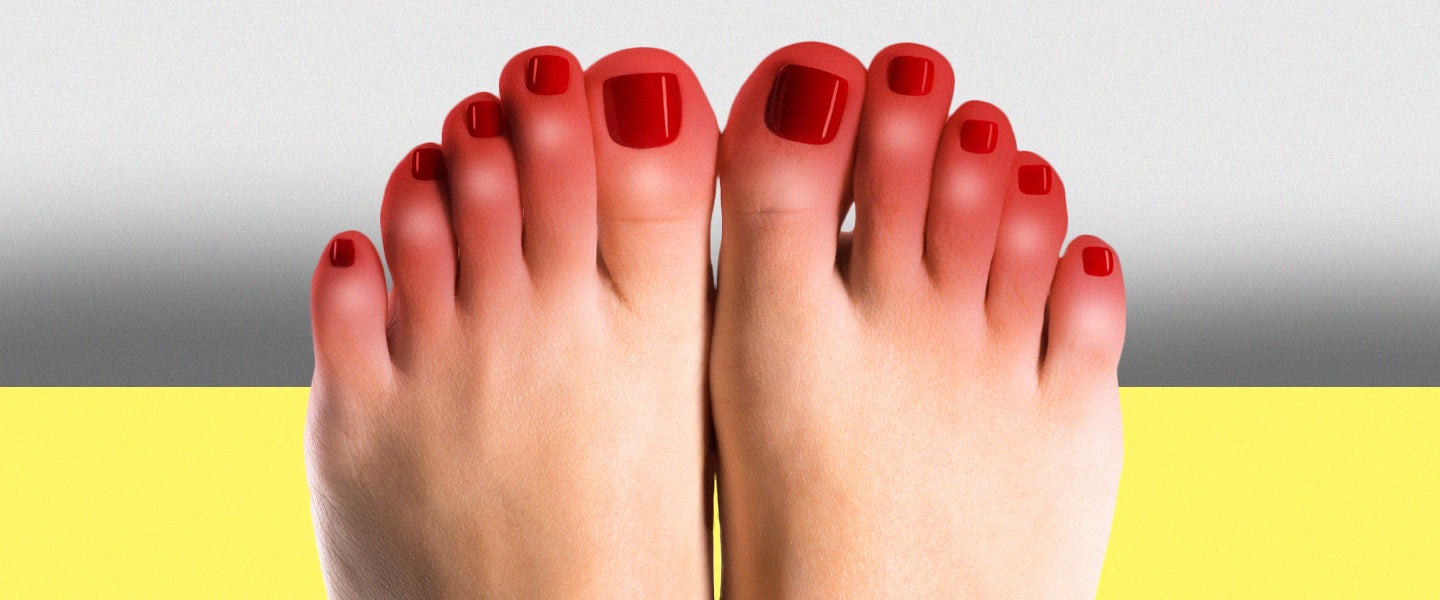As many of us barrel into month two of lockdown, a new COVID-19 symptom has emerged to keep us on our, um, toes. A growing number of dermatologists around the world have discovered that a frostbite-like foot rash and toe lesions that itch, burn and turn purple over time may be a delayed response to the coronavirus, otherwise known as the dreaded “COVID toes.”
Doctors suspect this delayed reaction to the virus occurs several weeks after the initial infection in young, healthy people with strong immune systems. This is both bad news for the lurkers of WikiFeet, as well as children, whose little piggies appear to be disproportionately affected.
On April 6th, Emily Deans’ 12-year-old daughter complained about itchy, swollen feet, which Emily assumed was a heat rash. But by the time her 10-year-old had the same symptoms a few days later, the Massachusetts-based psychiatrist had seen several case studies on COVID toes. Then she remembered when the entire family got mildly sick back in mid-February, before there was cause for much coronavirus concern in the U.S., especially among kids.
“I was like, ‘Holy crap, we might have had COVID,’” Deans tells me. She immediately sent a message to their primary care doctor, who referred her to a dermatologist for a telehealth appointment the following day. The dermatologist confirmed that the redness and sores on their feet were chilblains, sores and bumps that result from inflamed blood vessels, typically in response to cold air. “The odds of them both developing chilblains at the same time when it’s not cold out would be extremely rare,” Deans says. “So they most likely had it.”
Much of what’s known about COVID toes is preliminary and speculative. There have been a few case studies out of Italy and Belgium, which found that chilblains are either micro-clots in the blood vessels or inflammation of them. And since the coronavirus has been found to cause clotting and inflammation in other parts of the body, it’s possible that it’s both. The good news about COVID toes is that they appear to only occur in people who have not experienced any serious complications from the coronavirus. This, though, makes it a relatively low priority in terms of research compared to other life-and-death aspects of the pandemic.
“Young patients presenting with chilblains have lacked criteria sufficient to allow for a COVID-19 PCR test,” researchers note in the recent Belgium study. “Because of the recent outbreak of chilblains, concurrent with the increase of COVID-19 cases, COVID-19 has been widely suspected as the etiology.”
In other words, scientists have every reason to believe COVID-19 is the cause of these symptoms. However, the limited evidence available overwhelmingly suggests that COVID toes aren’t worrisome and that basic treatments like hydrocortisone ointments, Benadryl and ice all help.
Of course, such reassurance hasn’t stopped people from freaking the fuck out. “I had to add extra clinical sessions, just to take care of toe consults. People are very concerned,” Esther Freeman, the director of global health dermatology at Massachusetts General Hospital, told The New York Times. “The most important message to the public is not to panic — most of the patients we are seeing with these lesions are doing extremely well.”
Of all the strange things about this virus, a foot rash does actually make a lot of scientific sense. While these rashes can vary significantly, they’re a common response to viruses like measles, chickenpox, mono and hand, foot and mouth disease. And oftentimes, they will pop up after other symptoms, like a fever, have ceased and when people start feeling better.
“It’s kind of like a bruise resolving itself, the way it gets red, then purple, then green,” Deans explains. “The virus irritated the vasculature, and now, it’s healing. When you’re really sick, that happens in the lungs, in the brain and all over. But when you’re only a little sick, what they think is it only happens to the smallest blood vessels in your hands and feet.”
Deans’ daughters are recovering just fine, despite being a little itchy and irritated, and she’s waiting for antibody test results for herself and her husband, who didn’t experience COVID toes, but had fevers and coughs as part of that family sickness back in February. For now, her biggest fear is that the antibody tests come back negative and only raise more questions. “That would be hard because it would mean somehow the kids got it and didn’t pass it on to us,” she says. “But the kids almost definitely had it. That much we can say.”

